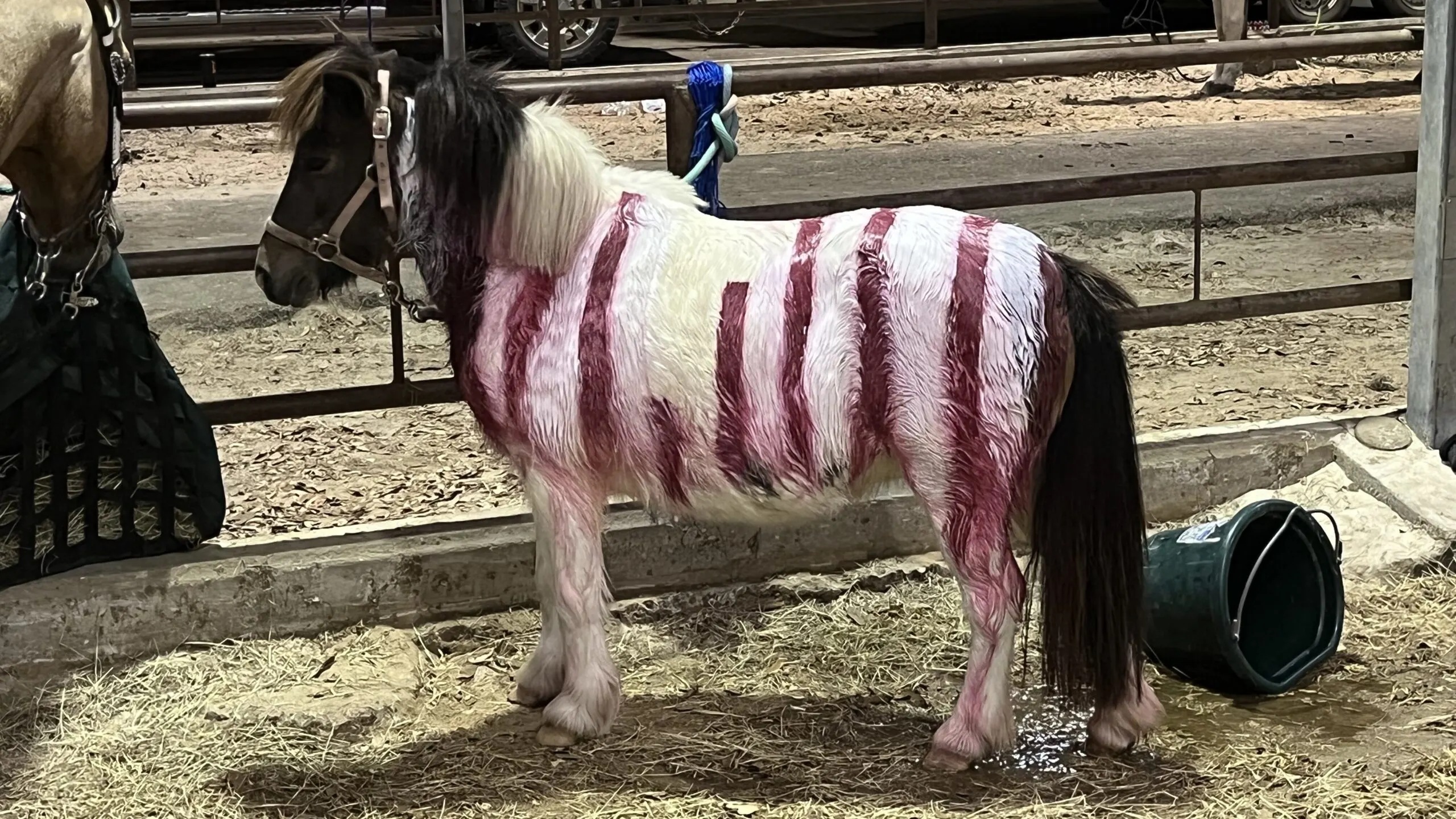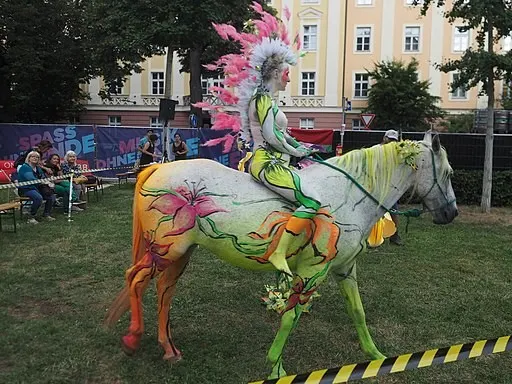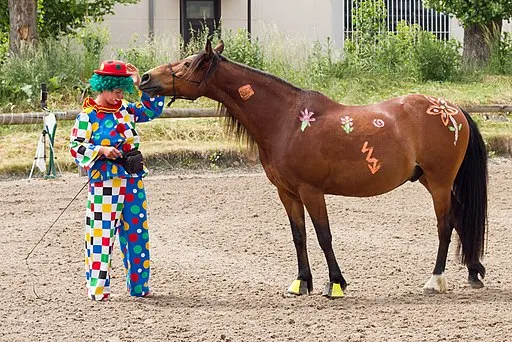Last updated: November 4, 2022
Any links on this page that lead to products on Amazon are affiliate links and I earn a commission if you make a purchase. Thanks in advance – I really appreciate it!
Two of our grandchildren compete in a weekly barrel racing competition. There’s always an award ceremony at the season’s end, and the kids come out riding decorated horses. This year we decided to paint theirs, but first, we needed to find safe animal paint.
Many different types of paint can be used on horses. However, you should always use milk-based or water-based products rather than solvent-based ones, with no heavy metals or creosote in the formula – and low VOCs (volatile organic compounds).
When it comes to painting horses, there are a few things you need to consider. The first is the type of paint you will be using. Different paints have different properties; some are better suited for painting horses than others. The second consideration is preparation. This blog post will focus on choosing safe paint for your horse.
This guide is for you if you want to paint or decorate your horse.
Here we will cover:
- Can you use regular paint on a horse?
- What are some safe horse body paint options?
- Is acrylic paint safe for horses?
- And more…

Can You Use Regular Paint on Horse?
Ever since humans domesticated horses thousands of years ago, they have become our favorite companions. Humans and horses always have shared an emotional, loving bond, and many consider them part of the family. It is little wonder that we want our horses to be part of our celebrations, occasions, and festivals.
Because it’s not practical to buy a costume for our horses, painting them is the best option. Painting a horse is especially popular during St.Patrick’s Parade and Halloween. But can you use regular paint on your horse?
Paint is only safe to use on horses as long as it is labeled as non-toxic. Look for water-based paints (also called latex paints). Water-based paints do not release harmful VOCs into the atmosphere. They also dry quickly and do not have a strong smell like oil-based and acrylic paints.
Most regular paints release toxic VOCs or volatile organic compounds into the air. Breathing these VOCs can cause eye irritation and respiratory problems for your horse.
Unfortunately, until recently, VOCs were considered essential for a paint’s performance until more research was conducted on them that showed their link with tissue irritation, allergies, etc.
Thankfully, more and more paint manufacturers have taken cognizance of the dangers of VOC-based paints and have started creating non-toxic, VOC-free paints.
One of the best options for painting your horse is milk-based paints. They adhere to a horse’s coat well, are non-toxic, and odorless, and come in deep rich colors.
If you want to paint your horse, please only use non-toxic paints. These days, you can find paints explicitly made for use on pets. In the next section, I have seven safe and non-toxic horse paint options for you.

Safe Horse Body Paints – 7 NonToxic Options
Here are some safe and non-toxic products for painting your horse:
#1. Kid-Safe Paints
Any paint that you can safely give your child to use is generally also safe for horses and ponies. Kid-friendly paints wash off quickly and do not leave ugly stains on the skin and clothes.
They are easy to apply, readily available, and completely safe and non-toxic. You won’t have to worry about releasing harmful compounds into the atmosphere.
You can also use child-friendly paints from top manufacturers on various surfaces such as pet skin, walls, paper, fabric, etc.
I recommend Crayola Washable Tempera Paint Kids Paint.
My grandkids used the Crayola Washable Tempera Kids Paint to decorate their ponies for parades and rodeos. I will be discussing Tempera paint shortly. It is a water-based paint that is safe for use on human and animal skin.
Features
- It can be easily cleaned with water and soap.
- Safe for kids and animals
- Non-toxic
- It can be easily mixed with other hues.
- It can be easily used on a variety of surfaces.
- Available in 12 amazing colors.
Expert Tips
- Always be mindful of the weather before you paint your horse. Avoid getting water on its mane and coat if it is chilly, as it could catch a cold.
Note: Crayola paint turns into a powder after drying and comes off easily when your horse rubs against anything and even when swishing its tail.
#2. Critter-Friendly Temporary Fur Paints
Another solution to ‘what paint can you use on horses’ is critter-friendly paint. Many people paint their dogs and cats, so pet-product manufacturers have created special paints that are safe for animal fur. You can safely use these paints for your horses too. Critter-friendly paints easily wash off after 1-2 baths or simply fade away after a few weeks on their own.
I recommend the Warren London Critter Color Temporary Pet Fur Coloring.
I haven’t used this pet paint, but my friend has used it as a temporary dye for her poodle’s tail. She reported that it was easy to apply and also dried very quickly. If it’s good for a poodle, it should be good for your horse, except you better expect to use a lot more.
You won’t have to worry about the color staining other items like your horse blanket, saddle pads, etc.
Features
- Temporary, safe, non-toxic
- Need not bathe your horse – the paint will fade away on its own after a few days.
- Won’t run or rub onto human skin, clothes, etc.
- Available in 7 attractive colors.
Expert Tips
- All colors work well on light-colored horses. But for darker colors, some products may not show.
- Use a blow dryer to dry your horse faster.
#3. Pony Paint Grooming Chalks
Grooming chalk paints are also a safe horse body paint option. The best part is that it is specially made for use on horses and ponies. You can use vibrant-colored grooming chalk powders to create attractive designs and patterns on your dark or light-colored horse or ponies.
Pony paint chalks are easy to use, non-toxic, safe, and kid and animal friendly. You can use them during parades, shows, St.Patrick’s Day, Halloween, and other events.
I recommend the Tail Tamers Horse Grooming Chalk.
My granddaughter recently used this on her pony before a rodeo, and everyone loved her design.
Features
- Safe and non-toxic
- Easy to hose off or fade away on its own.
- You can apply it with your fingers or a paintbrush and even use it with stencils, etc.
Expert Tips
- Use it with Tail Tamer’s Pony Glitter for a shinier effect before rodeos.

#4. Food-Grade Airbrush Cake Paints
Another safe horse body paint is food-grade airbrush paints that are used for painting cakes, cookies, etc. The advantage of using food-grade paints is that you won’t have to worry about your horse licking it accidentally. Moreover, food-grade paints wash away relatively easily.
I recommend the U.S. Cake Supply Airbrush Cake Color Set.
If you have an avid baker in the house, then you have probably seen these cake paints. The entire set consists of 12 attractive colors. You can apply them quickly on your horse using convenient spray bottles or airbrush guns/nozzles.
Features
- Highly concentrated dyes
- Easy application
- Made in the USA
- Kosher, halal, gluten-free
- You can also create different colors by intermixing the 12 shades.
Expert Tips
- Spray lightly. Allow the first layer to dry completely before applying another coat.
#5. Pet-Hair Spray
Pet hair spray is another safe option for painting your horse or pony. The best part is that pet hair sprays are free from dyes that irritate and dry pets’ skin.
These sprays are temporary, non-toxic, and very safe. Colored hairspray designed for humans should also work well.
I recommend the Petway Petcare Pet Hair Spray.
Features
- No propellant gases or aerosol
- Safe, eco-friendly, non-toxic
- Dye-free
- Temporary
- Comes off easily. They wash off in one bath.
- Available in 9 awesome colors.
Expert Tips
- Use brighter hues like pink or yellow if you plan to use it on black/dark-colored horses or on their manes.
#6. Human-Grade Light Face and Body Paints
Human-grade face and body paints are easy to apply, dry off quickly, and wash away easily. Many people use these creamy textured paints on their dogs, cats, and horses, and they do not seem to bother the animals.
I recommend Midnight-Glo Neon Flourescent Body-Face Paints.
Features
- Creamy, smooth texture
- Easy application and removal
- Ideal on dark-coated horses
- Glow in the dark
- Available in 8 amazing colors.
Expert Tips
Use a brush and your fingers for a smoother, more even application. It may take you some time to work with these body paints to get the effect you’re looking for.
#7. Henna
Henna is a natural plant-based dye that is safe and non-toxic for dying and coloring hair and skin. Many cultures in the East have been using henna for centuries to dye their hair and hide the greys. Henna dye is even used during Asian weddings to draw beautiful red-colored patterns on the bride-to-be’s hands and legs. The dye lasts for several days too.
You can use henna on horses, but it will only be visible on light or white-colored horses. Henna leaves a semi-permanent reddish-orange color on the skin and hair- so it won’t be seen on chestnut, black, or dark brown horses.
The application of henna is also slightly tedious in that you have to apply a lot of the paste and leave it on for at least 6-8 hours. After drying, you need to wash off the paste completely.
Note that many commercial henna products contain harsh chemicals like indigo which could leave an allergic reaction on your horse’s skin. So only choose natural, completely non-toxic henna.
I recommend Zenia henna which is chemical-free and completely safe for humans and animals.
Features
- Safe, completely plant-based, and non-toxic.
- Free from peroxides, heavy metals, pesticides, and preservatives.
Expert Tips
- Use gloves to apply it, as henna could stain your hands red.

Is Acrylic Paint Safe for Horses?
I advise against the use of acrylic paint on a horse. Ask yourself: would you use acrylic paint on your skin? On your face? The answer is no. So, why would you use it on your horse?
Acrylic paints can be extremely drying. They contain acrylates which are also known skin irritants. Humans and animals could both develop eczema, skin irritation, itchy skin, and a host of other issues due to acrylates in acrylic paints.
Secondly, acrylics dry up and harden and become very stiff with time. If you try washing your horse after using acrylic paint, you might rub its skin raw. The paint will take days to come off.
So, please avoid using acrylic-based paints for painting your horse or pony. Only go in for water-based Tempera paints or one of the options I have recommended above.
Is Crayola Paint Safe for Horses?
Crayola paint is safe for horses. People even use them to create dog-paw art with their kids, which further endorses their safety and non-toxicity. Dogs and other pets might lick the paint, but you won’t have to worry about getting sick from it.
Crayola brand has been around for decades, and its paints, crayons, chalk, and other products are deemed safe for children. Even toddlers who put everything in their mouth are safe around Crayola products.
So you can safely use Crayola paint to create beautiful patterns on your ponies or horses.
Is Tempera Paint Safe for Horses?
Tempera is a water-based paint. Compared to acrylic paint, Tempera paint is creamier and thinner. It is also easier to mix. The best part is that Tempera paints are labeled non-toxic.
Being water-based, Tempera paints are entirely safe to use on horses’ skin and mane and even on dogs’ paws. They are easily washable, meaning they will come off on your hands and clothes should they get messy while painting.
You can also use Tempera paint on your horse and wash it off after a couple of days without worrying about the paint leaving behind unsightly color.

How To Make Horse Safe Paint?
If you plan a horse-themed party, you can DIY non-toxic and safe homemade paint to color your horse. My friend gave me this wonderful homemade paint recipe which I plan to try out soon.
It is made using human-grade food materials, so you can trust that it won’t harm your horse in any way.
Ingredients
- ½ cup each: salt, water, flour
- Few drops of food color that you like.
Method
Mix the first three ingredients and add the food coloring. Whisk the mixture until it is lump-free and uniformly mixed.
How to apply paint on a horse
You can now use a brush to paint some patterns using the paint/s mentioned earlier on your beloved horse. To get your horse ready for painting, use the following steps:
- Clip your horse – the shorter its coat, the easier it will be for the paint to stick. If your horse has a long mane, braid it first to keep out of the paint.
- Bathe your horse first if it is really dirty; otherwise, the mud won’t let the paint stick.
- Apply the paint/patterns as desired. You may need another coat if needed.
- Use a hairdryer to dry the paint.
- Always make sure to dry your horse completely before turning it out.
Below is a YouTube video about painting horses.
FAQs – What Paint Can You Use on Horses?
What paint is safe for livestock?
Any human-grade, water-based paint labeled explicitly as non-toxic is safe for use on or near livestock. There are acrylic paints specially made for painting barns and fences that keep livestock safe. These may be safe to use around livestock but are not intended for use on animals.
Is it safe to whitewash inside a horse’s stall or barn?
Whitewashing is an old-fashioned method to brighten and protect wood inside a stall or barn. It is done using powdered limestone mixed with water. Although it’s a handy option for sealing tough-to-clean surfaces against bacteria and insects, the process needs to be repeated annually.
Conclusion
Painting your horse is a great way to make it prettier for a parade or for special events like Halloween and other festivals. Always use safe, non-toxic, water-based paints for painting on your horse.
Paints like Tempera-based paints and Crayola kid-friendly paint are the best options for painting on a horse. You can also use human-grade face paint or special critter (temporary) dyes, or pet hair color sprays for the job. Avoid using harsh acrylic paints as they are tough to remove and toxic due to the presence of harmful VOCs and acrylates.
Meet Miles Henry
An avid equestrian and seasoned racehorse owner, Miles Henry brings his extensive experience to the equine world, proudly associating with the AQHA, The Jockey Club, and various other equine organizations. Beyond the racetrack, Miles is an accomplished author, having published various books about horses, and is a recognized authority in the field, with his work cited in multiple publications.
🔗 Connect with Miles:
Twitter
Facebook
YouTube: Check out race highlights, horse care tips, and more!

